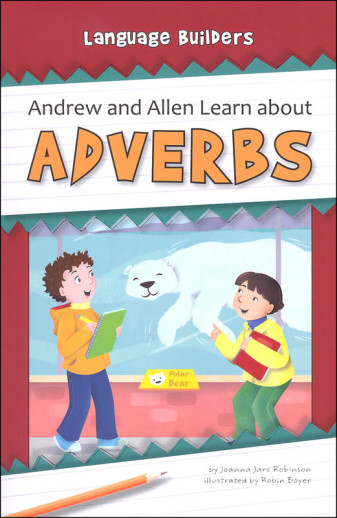We use cookies to make your experience better. To comply with the new e-Privacy directive, we need to ask for your consent to set the cookies. Learn more.
Andrew and Allen Learn about Adverbs (Language Builders)
Andrew and Allen are taking notes about animals at the zoo. They use adverbs to describe where, when, and how the animals move, eat, sleep, and play. Do the giraffes graze gracefully? Does the bear sleep peacefully? Concepts covered include: basic definition and usage of adverbs; comparative adverbs; adjective modifiers and other adverbs; recognizing adverbs; spelling: ly, ily, ely; and superlative adverbs. Writing activity in the back reinforces text concepts. Glossary and additional resources. The Language Builders series helps young readers learn how to use the English language correctly. They join in on the fun as friends learn the basics of finding different types of words in a sentence and using them correctly. Each book in the Language Builders series covers a different part of speech. From adjectives to interjections, they learn how these parts of speech electrify writingwow! Activities in the back of the book provide additional information and practice identifying and using each part of speech.
To introduce parts of speech, try a story! In this series, a child learns the basics of identifying and using parts of speech. In a clear, straightforward presentation intertwined with storytelling, each book introduces us to two main characters who are learning (often from each other) the different parts of speech: adverbs, adjectives, conjunctions, interjections, nouns, prepositions, pronouns, and verbs. In each book, these pairs of children ages 8-10 (whose names also start with the same letter as that particular part of speech) have some tasks before them. We learn that task through a note on the first page written from the main character. Then as we engage in the story, the characters discuss aspects of the part of speech. For example, as Paula and Patrick play a game of hide-and seek, Paula helps Patrick understand that Prepositions show location and they need other words to help them do so. Most of the story lines are spurred from classroom situations such as class field trips, teachers giving specific assignments, or Phillip missing days from school as a result of illness. While some of these situations might be unfamiliar to home school students, I think the stories are easily applicable to the home school environment and might also serve as ways to introduce and have discussions about some aspects of brick-and-mortar education.
Usually each two-page spread contains a full-color illustration and then a full page of text. Occasionally, we see the character's written work to help reinforce points. At the book's end, you'll find a summary description of the part of speech with sample sentences, a mini glossary and additional references for further study. You'll also find a writing activity-from creating word lists to writing short stories-to help your student apply what's been learned. A nice series to help students bridge the connection between grammar and use in life. 5.5" x 8.5", 32 pp, sc. ~ Ruth
| Product Format: | Paperback |
|---|---|
| Grades: | 2-4 |
| Brand: | Norwood House Press |
| Author: | Joanna Jarc Robinson |
| ISBN: | 9781603577045 |
| Length in Inches: | 8.5 |
| Width in Inches: | 5.5625 |
| Height in Inches: | 0.125 |
| Weight in Pounds: | 0.15 |

